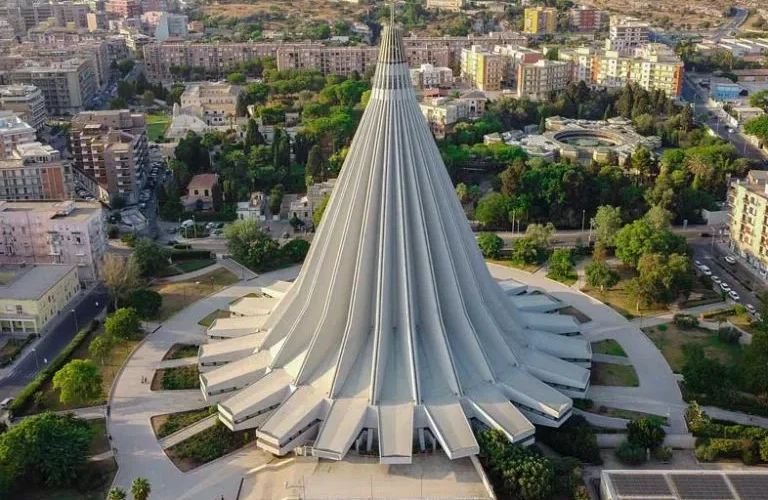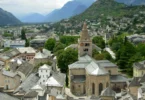
Introduction
The Basilica of the Madonna delle Lacrime (Basilica Sanctuary of Our Lady of the Tears), also called Madonnina delle Lacrime is a 20th-century Roman Catholic Marian shrine church in Siracusa in Sicily, Italy. The modern building, derided by some as an inverted ice-cream cone, dominates the skyline of the approach to Ortigia.
The “Our Lady of Tears” sanctuary is one of the most bizarre monuments or churches in all of Sicily. Designed to evoke a gigantic teardrop, the structure was created by two Frenchmen, Michel Arnault and Pierre Parat, in 1994. It houses a statue of the Madonna that supposedly wept for 5 days in 1953. Alleged chemical tests showed that the liquid was similar to that of human tears. Pilgrims still flock here.
The work was designed in 1957 by the French architects Michel Andrault and Pierre Parat following an international competition, but the structural works are by the engineer Riccardo Morandi. Built between 1966 and 1994, the church was elevated to the status of a minor basilica by John Paul II in 2002.
The Church Sanctuary of the Madonna of Tears is almost 80 metres high and therefore the tallest building in all of Syracuse. Madonna and the church are open to the public and are the destination of many pilgrims who hope that a visit will alleviate them of their ailments. Every second Sunday of the month, masses in (Italian sign language) are held for the deaf.
History of Santuario Madonna delle Lacrime, Syracuse

For the construction of the Sanctuary, an international competition was organized in which 100 architects of 17 nationalities participated. The winners of the competition were two French architects: Michel Andrualt and Pierre Parat.
The temple begun in 1988 was inaugurated on November 6, 1994 by St. John Paul II, invited by Archbishop Giuseppe Costanzo today Archbishop Emeritus of Syracuse. The Sanctuary is about 103 meters high; 94.30 meters from the walking surface.
The huge ceremonial “hall” is faced with marble reflecting the star: the Virgin Mary of the morning, preceding the rising of the sun – Jesus.
The shape of the Sanctuary is subject to various interpretations. The architects intended to structurally realize the concept and sense of elevation of humanity towards God. Other meanings attributed to its shape are those of: lighthouse, identifiable with Mary who leads towards the port which is Jesus; tent inside which the Mother welcomes her children to lead them to the Father; tears falling from the sky.
At the top of the Sanctuary you can see, housed in the radial pattern, a statue of the Madonna, in gilded bronze, which reproduces the entire image of the little picture that cried. The statue is about 3 meters high and weighs 600 kg. The project is by Francesco Caldarella. Mary is represented with her arms outstretched towards the main entrance, as if to welcome her children into the Father’s house.
Architecture and Features

The Sanctuary is divided into two levels: the basilica, at the top, and the crypt, at the bottom. The upper temple, circular in plan and 71.40 meters in diameter, has capacity for 11,000 people standing and 6,000 seated. Around the perimeter there are 16 chapels. In the center, an altar in white marble and stone from Modica, the work of Giancarlo Marchese, houses the image of the Madonna delle Lacrime and an 18th- century cross.
The crypt is dedicated to the Immaculate Heart of Mary. Also circular, it has a diameter of 80 meters and can hold 3,000 seated people. Archaeological remains from the late Roman period are preserved, such as a hypogeum. Several chapels are distributed around the perimeter and the ex- votos of the faithful are exhibited. The vial containing the tears of the Virgin’s miracle is also kept in the crypt.
Externally, the building is crowned by a conical reinforced concrete roof, 103 meters high, topped with a bronze statue of the Virgin, the work of Francesco Caldarella.
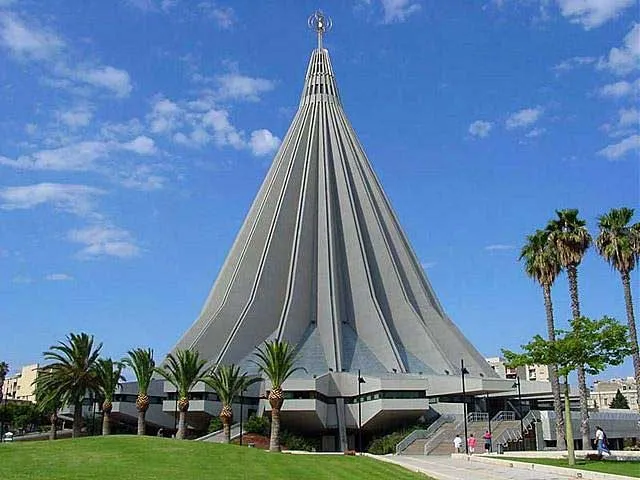
The Altar of the Basilica
The altar is the work of the sculptor Giancarlo Marchese; it has a square shape and consists of two parts.
The bronze base consists of four panels that reproduce some scenes from the book of the Apocalypse: the throne; the new Jerusalem; the lamb; the tree of Life; the column; the roll.
The large canteen is in Modica stone. The edge of the table is engraved with a phrase in Greek: “Christ loved the Church and gave himself up for her”.
Marchese’s work is entitled: “New heavens and a new earth” because it aims to express the conclusion of the story and the return of Jesus.
Above the altar is the precious crucifix by an unknown artist from the 1700s.
The Weeping Madonna of Syracuse
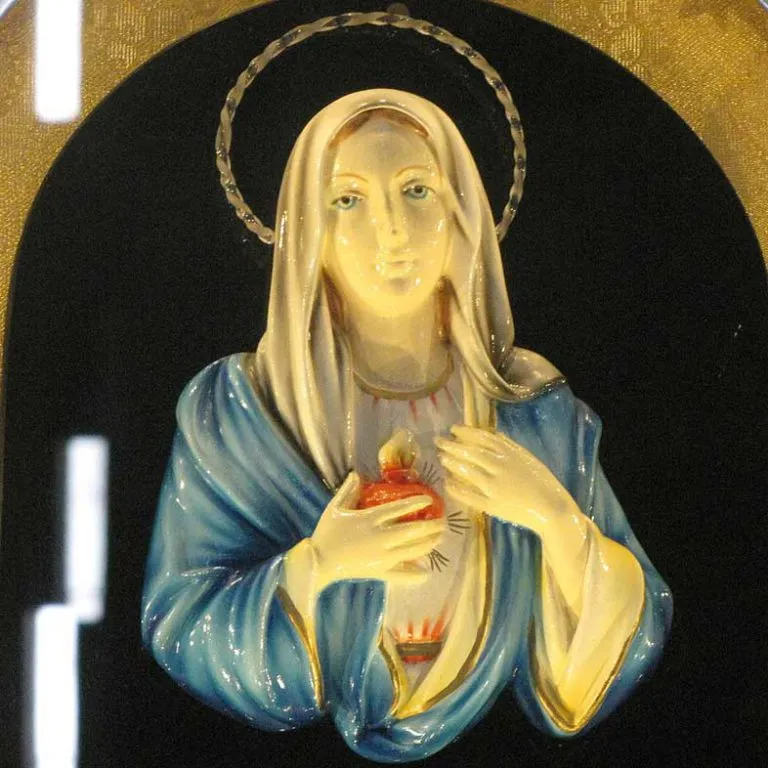
The Weeping Madonna of Syracuse is one of the most unusual of the approved miraculous images of the Blessed Virgin Mary and it is one of the latest. Another remarkable fact is that although this image is world famous there are few sites featuring Our Lady of Syracuse and the miracle.
Mary has many sites on the web that extol her virtues, her intercessory powers, her hope for sinners, her beauty and power with God, Madonna art and lore, but no major American site on this Madonna; so we decided to post one of our own:
The more Mary is desecrated in society and on the websites seem to be popping up on the web the more Catholic Tradition wants to offer the Mother of God as hope for the world, her merciful bounty, her beauty and power with God, her hope for sinners who think they are hopeless and have no one to make sacrifices for them or to pray for them, hope in the midst of the darkness of modern despair, materialism, lust, and the new pantheism that has attached itself to certain aspects of the environmental movement and even in the Catholic Church.
History of the Weeping Madonna of Syracuse, Sicily 1953
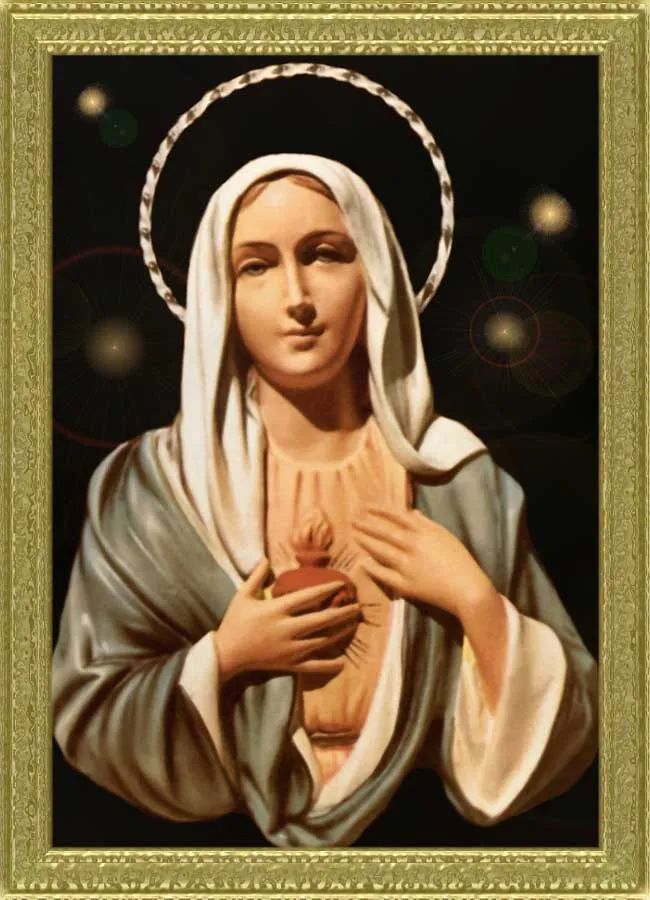
The image you see above is a print of a plaster sculpture or plaque, of the Immaculate Heart of Mary; the plaque was mass-produced in Tuscany, italy and shipped to Syracuse for retail. One of the plaques was purchased as a wedding gift. After it had hung in the humble home of the Iannuso couple, the image unexpectedly and prodigiously shed tears for four days.
The veneration paid this image in a church built especially for it has been approved by three Popes, but only after an ecclesiastical tribunal scrupulously studied the miracle and had the tears scientifically examined. It has been said that never has a miracle been so thoroughly investigated, nor approved so quickly.
The history of the image begins with the sculptor, Amilcare Santini, who modeled it in three days “under artistic inspiration.” It was made of plaster dissolved in water and poured into a mold and turned out to dry in the sun. it was then sprayed with a varnish to render it suitable for painting.
The Phenomenon of Tears
One of the plaques was given as a wedding gift as we said, to Antonina and Angelo Iannuso who were married on March 21, 1953. At the time they were tepid and neglectful christians, they said, but they hung the image with some devotion on the wall behind their bed.
Angelo was a laborer who had taken his bride to live in the home of his brother on Via Degli Orti 11, Syracuse, Sicily. When Antonina discovered she was with child, she was unfortunately afflicted with toxemia that caused her to convulse at times and experience some blindness. At three in the morning on Saturday, August 29, 1953, Antonina suffered a seizure that left her blind.
By 8:30 that morning her sight was restored; when she was able to see, her eyes were on the Madonna, which, to Antonina’s amazement was weeping effusive tears. At first the others thought she was hallucinating due to her illness, but Antonina insisted she wasn’t. her family looked again and they could see the tears run down the Madonna’s cheeks and onto the bed. The neighbors were brought in and they confirmed the tears.
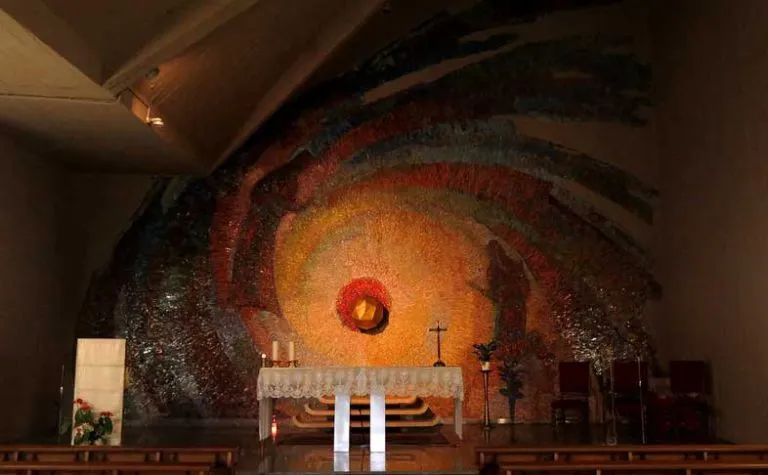
The Examination
One of the many visitors who examined the plaque at close range was Mario Messina, who was highly regarded in the neighbourhood. After observing the slow formation of the tears, he removed the image from the wall looked at it thoroughly and was satisfied that the tears was not the result of an internal reservoir. After the plaque was dried, two tears immediately reappeared.
News of the phenomenon spread rapidly throughout the city, bringing crowds that forced their way indoors and gathered in the streets around the house. The security inspector, with the couple’s permission, hung the plaque on the outside of the house to satisfy the curiosity of the people, but later, seeing that the crows showed no sign of diminishing, the picture was taken to the constabulary in an effort to reduce the confusion.
The image wept while outside the building and during its transport, but after 40 minutes at the police, when it did not weep, it was returned to the Iannuso home.
On Sunday, August 30 at 2:00 in the morning, the weeping image was placed on a cushion and displayed for the curious who had remained in the street throughout the night. The plaque was nailed above the main door on Monday, and its tears collected by the people on pieces of cloth and wads of cotton. During this time skeptics became convinced, and many of the sick were healed. That same Monday, to protect the plaque from falling, it was brought to an improvised altar outside the home of the Lucca family who lived across the street; after the recitation of the Rosary, it was returned.
Three priests visited the home during this time, one of whom notified the chancery, which assembled a group of clergy, four of scientific background and three for reputable witnesses, to comprise an investigating commission. On the specific instructions of the chancellor, the group met at the Iannuso home on Tuesday, Sept. 1 to study the phenomenon, collecting a sample of tears for analysis. The plaque was examined while it wept and while the liquid collected in the cavity formed by the hand over the heart.
The commission examined the smooth finish and found no pores or irregularities on the surface. The backing was removed and the unfinished gypsum was scrutinized and found to be dry, even though tears collected on the reverse. Six coats of nitrocellulose colors were counted on the image; these were covered with varnish. Using a sterilized pipette, a sample of tears was collected, placed in a sterile vial, and taken to the provincial laboratory to be examined by doctors and chemists.
Following a detailed analysis the doctors reached this conclusion: The liquid examined is shown to be made up of a watery solution of sodium chloride in which traces of protein and nuclei of a silver composition of excretory substances of the quaternary type, the same as found in the human secretions used as a comparison during the analysis.
The appearance, the alkalinity and the composition induce one to consider the the liquid examined analogous to human tears.
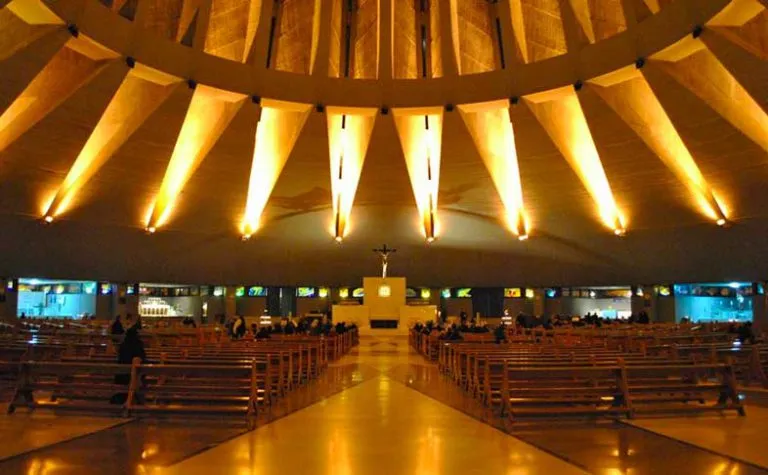
The Church's Declaration
The report was dated September 9, 1953 and signed by the examining doctors. Concerning this commission and the various investigations conducted, we must realize that the Church is never in a hurry to pronounce her judgments on such occurrences and that She acts with maximum caution and prudence, ready to affirm miracles only after positive and unquestionable proofs have been extended. Nevertheless, sufficient proofs were apparently given, since a favorable judgment was rendered in a relatively short time.
The Archbishop of Syracuse visited the Iannuso home to examine the image and returned another day to recite the Rosary with the crowd. Various monsignori visited the image, some of whom witnessed the weeping. Many Cardinals expressed interest, while the Archbishop of Palermo, Ernesto Cardinal Ruffini stated:
After careful sifting the numerous reports, after having noted the positive results of the diligent chemical analysis under which the tears gathered were examined, we have unanimously announced the judgment that the reality of the facts cannot be put in doubt.
Pope Pius XII, in a radio broadcast on October 17, 1954 said: We acknowledge the unanimous declaration of the Episcopal Conference held in Sicily on the reality of the event. Will men understand the mysterious language of those tears?
Miracles and the Reliquary
The medical commission that was nominated on October 7, 1953 to scientifically examine the 290 cases of reported cures, decided that 105 of these were deemed to be of “special interest,” or likely miracles, which were reported within a few years of the incident. The first person to experience a healing was also the first to observe the weeping. From the time Antonina Iannuso first saw the tears, she recovered completely from severe toxemia and gave birth to a healthy son on December 25, 1953.
This is all the knowledge that we have of the miracles specifically. But we do know that the Weeping Madonna caused a world-wide sensation around the world. That this interest was the result of collective hallucination is rejected by authorities of the shrine where the image is now kept. Apart from the separate groups observing the tears in several locations, there was the tangible evidence of the saturated cloths and cotton.
Numerous unbelievers or skeptics tasted the salty tears for themselves, thus excluding hallucination by over-excited believers. Moreover, there was motion film coverage of the actual weeping. The question of condensation is also eliminated because that would have necessarily have had to include the entire image and nearby objects, but only the corners of eyes were emitting the tears.
The reliquary presented to Archbishop Baranzini on the occasion of the fiftieth anniversary of his ordination ids of special interest since it contains the tears collected by the commission. The reliquary is comprised of three layers, the bottom of which contains cloths saturated with the tears, a vial of the tears and some cotton wool that had absorbed the tears; the second layer has four panels depicting the events. The third and highest layer has a crystal urn which holds another vial of tears: the tears in it are now crystallized.
The little house on Via Deggli Orti 11, where the Madonna first wept, is now an oratory where Mass is often said. The image itself is enshrined above the main altar of the Santuario Madonna Delle Lacrima, built especially to accommodate the crowds that continue to gather to pray before the holy image.
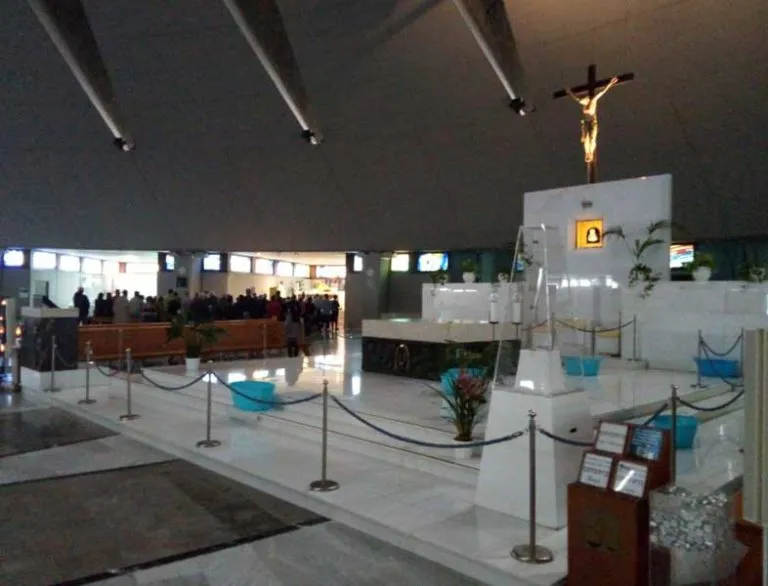
Significance
Why did the Madonna weep? Many theories have been offered which remind us of the tears Mary shed at the foot of the Cross and of those shed by her at La Salette. During one of the visions of St. Catherine Laboure on July 18, 1830, St. Catherine noticed that the Virgin looked sad and had tears in her eyes. Perhaps we should pray the words engraved on the base of the reliquary and wonder with Pope Pius XII if men will understand the mysterious language of the tears.
The Chapels
There are 16 chapels in the Sanctuary. Looking at the altar, on the left there is the chapel of the Sacramento where the Holy Mass is celebrated every morning; next to it a chapel is dedicated to the Holy Shroud. On the left there is the chapel dedicated to San Giuseppe, with a wooden statue and to follow the Chapel of San Pio da Pietralcina, of which we keep his handkerchief given to Signora Antonina Iannuso and copies of the images, of the Madonna delle Lacrime with prayers written by Saint Pio.
The Gate
The majestic entrance door entirely in bronze, the work of the sculptor Giacomo Albano, represents the door of a sheepfold and bears a verse from the Gospel of John engraved in Greek. On the outside: “I am the door, if anyone enters through me he will be saved”; on the inside: “He will enter and will go out and find pasture”. Jesus is the door that leads to the Father.
The Crypt
The Crypt was inaugurated on August 28, 1968. Circular in shape, it has an external diameter of 80 m, the internal one of 38 m and a height of 9 meters. It can be accessed from 18 entrances and has a capacity of around 2,000 seats. The central altar is placed on a red granite pavement. The semicircle presbytery wants to give the idea of hospitality. The picture of the Madonna was on this altar from 1968 to 1987 and from 1st May 1994 to 4th November 1994.
In the Crypt there are several chapels. The Chapel of the Sacred Heart houses the Blessed Sacrament. The mosaic represents the apparition of the Sacred Heart of Jesus to St. Margherita Alacoque. Everything is wrapped up in a colorful vortex that converges in the golden diamond-shaped Tabernacle.
A Chapel is used for the celebration of the sacrament of Reconciliation; the Chapel of St. Peter and Paul in which the two pillars of the Church are represented, there is an iconostasis. Here the celebrations of the Eucharist take place in the Orthodox rite; the Chapel of Santa Lucia, patroness of Syracuse, houses the tomb of SE Mons. Calogero Lauricella, Archbishop of Syracuse from 1973 to 1989, worked for the construction of the Sanctuary to Mary towards whom he nurtured a filial devotion.
The funeral monument was designed by the surveyor Franco Vasquez, the bronze bust is the work of the master Francesco Caldarella; in yet another there is the Museum of ex-votos where part of the many gifts given to Mary “for grace received” are exhibited.
The crucifix at the main entrance is also kept in the crypt, painted on beech wood by the artist Francesco Scialfa, who entitled it the “Christ of Light”: from the hands, from the feet, from the head, bundles of light, a light that recalls the resurrection event.
The Byzantine Hypogeum
Looking at the main altar, on the left side there is an archaeological find, a Byzantine-late ancient hypogeum or a burial chamber, under which there are two Greco-Roman rooms (not accessible) near which a small stream flows.
The Museum of Lachrymation
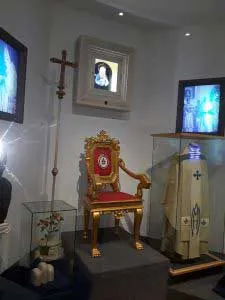
In the Museum of Lachrymation unique pieces are collected, connected to the event of Lachrymation. The pipette and the slide used in the laboratory by the medical commission to carry out the chemical analyses. The wooden cross that led the first pilgrimage in history to the feet of Our Lady of Tears. The desk on which the official deeds attesting to the prodigy of the Lachrymation were signed.
Furthermore, some of the most precious and artistic gifts made to the Madonnina are on display. A space, however, is dedicated to the memorial of St. John Paul II who visited the Basilica of the Madonna delle Lacrime on the occasion of the dedication of the Sanctuary on 6 November 1994.
The Museum of Ex-Votos
In the “Museum of Ex-Votos” a small part of the gifts given to Mary, “by grace received”. From the first days graces and mysterious healings were manifested among the many faithful present, physical and spiritual healings. The gifts that are still preserved are: crutches, busts, braces and then again wedding dresses, paintings, embroideries, representations of the Madonnina. There are gifts for twinning made with other Shrines and plaques in memory of the visits of the Reliquary of Mary’s tears to other Ecclesial Communities.
The Museum of Vestments and Cribs
The Museum collects and preserves ancient vestments, from the 18th and 19th centuries, donated over the years to the Sanctuary of the Madonna delle Lacrime and a beautiful collection of nativity scenes of various workmanship and origins.
The Museum of Vestments, with entrance from the Crypt churchyard, now renamed the ” Pope Pius XII Museum “, the Venerable Pope who in 1954 with a radio message from Vatican Radio, expressed the still current question: ” Will men understand the arcane language of those Tears? ”.
Already in 2016 there was an attempt to reopen, thanks to the contribution of Lukoil which supported the initiative, but a flood thwarted the renovation work.
Today, this Museum, designed by the Rector Mons. Michele Giansiracusa, closed several times following the floods, allows everyone to appreciate the terracotta nativity scene, donated by the late Prof. Luigi Scapellato – former Chief Physician of the Umberto I Hospital in Syracuse. It was the Rector Mons. Pasquale Magnano who, in 1993, accepted the donation, jealously guarding it in the premises of the Sanctuary. A unique work of its kind, finally exhibited for the visit of the faithful and pilgrims on a permanent basis.
Permanent Exhibition on the History of Our Lady of Tears
The permanent exhibition on the history of the Madonna delle Lacrime is exhibited in the crypt. Backlit panels make the story of Our Lady of Tears visible, from 1953 to today: pilgrims, through a simplified itinerary made up of original images and captions, are introduced to the mystery of those Tears that prodigiously flowed from the face of an enamelled plaster bas-relief of the Madonna.
In addition, two blow-ups of the Lacrimation of the Madonna and of Padre Pio have also been placed; the latter devotee of Our Lady of Tears gave his handkerchief to Signora Antonina Iannuso, now kept in the Sanctuary.
Feast Day - 29th August
The Madonna was weeping for four days, from August 29 to September 1, on numerous occasions and attracted thousands of pilgrims in Syracuse. Feast Day of Our Lady of Tears (Weeping Madonna) held on 29th August.
Mass Time
Weekdays
Sundays
Church Visiting Time
Contact Info
Santuario Madonna delle Lacrime,
33, Via del Santuario,
96100, Siracusa SR, Sicily, Italy.
Phone No.
Tel : +39 0931 21446
Accommodations
How to reach the Sanctuary
Catania–Fontanarossa Airport, also known as Vincenzo Bellini Airport, is an international airport located in southwest of Catania, the second largest city on the Italian island of Sicily is the nearby Airport to the Sanctuary.
Siracusa Transit Station of the Italian city of Syracuse, in Sicily is the nearby Railway Station to the Sanctuary.

